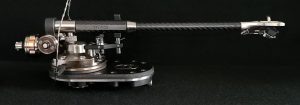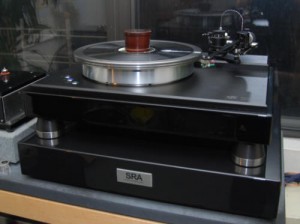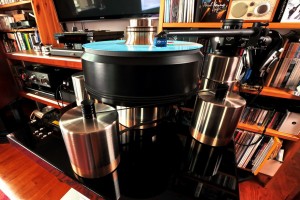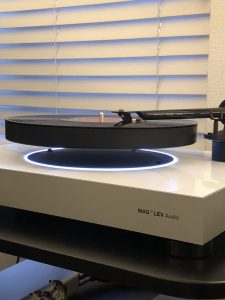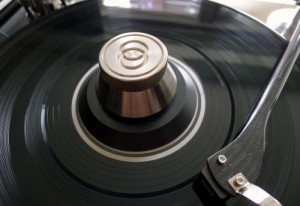"It's style over substance," I thought, seeing the Tentogra Oscar turntable for the first time. It was during the Audio Video Show 2017. "It's probably style over substance," I said to a friend when I saw the same turntable a year later at the Audio Video Show 2018. The change was subtle, because "probably" does not make a summer.
Fun fact 1 - Ksawerowa, a village near Łódź, is the only one in Poland with a tram connection. Fun fact 2 - it is one of the few villages in the world where high-end turntables are made.
Do you remember the scene of a dam being blown up from the Force 10 from Navarone (directed by Guy Hamilton, 1978)? A small explosive charge apparently did not make a dent on the huge structure. It just "scratched" it. The rest, however, was done by nature. I think it was the same with me and the Tentogra Oscar turntable from Ksawerowa. After the initial shock, quickly, when I learned where its form came from, when I listened to how it was built and when it finally spent some time in my system, its shape became familiar and more natural to me.
The founder, owner and chief designer, Mr. Wojciech Samołyk described it this way:
The construction of the Tentogra turntable was my idee fixe. I wanted to pay tribute to both music that would achieve the best possible reproduction and setting, and an architect who is an incomparable master for me. I wanted to combine my two first and longest-lasting loves.
tentogra.pl, accessed on: Feb. 18th 2019
The master he mentioned is Oscar Niemeyer, and the tribute is the form of a turntable named after him. Although Oscar Niemeyer (1907-2012) is no longer with us, he still belongs to the world's leading contemporary architects. His most important projects include buildings in Brasilia, the new capital of Brazil, from the 1957-1964, the Cathedral of Our Lady of Aparecida, or the Seat of the French Communist Party. Another of his achievements is the National Congress building located at the Plaza of the Three Powers.
Please take a look at this building and you will better understand where I am today, and the form of the turntable we are talking about will become understandable and even natural as if it were the only possible one. Of course it is an illusion, turntables have quite specific acceptable shape and form. However, the Oscar turntable expands this pool and for me it will always be one possible ones, next to such extraordinary designs as the Preambulator by Metaxas & Sins, Kronos Sparta, or La Luce, a designed prepared by the Spotheim.
A few simple words…
WOJCIECH SAMOŁYK
Owner, designer
Mr. Wojciech Samołyk, a young student working on his project.
My adventure with turntables started while I was still fascinated with the CD in 1999 when with my friend, also an architect, I tried to build a turntable. It never got out of the designing stage, we never even tried to actually build one. Over the period of the next 16 years, I built a large collection of audio devices from the 1960s and 70s. The concept of building a turntable has matured over the years. I studied designs of many old turntables. As an advanced audiophile, I also owned some interesting modern designs, such as the SME 20/2, J. Sikora, Transrotor, and others.
When I tried to convince my friend to work with me to build turntables together, he refused. Finally, four years ago, I dared to try to design my first turntable by myself. I was encouraged to do that by Mr Jerzy Owsiak—the man behind The Great Orchestra of Christmas Charity (W.O.Ś.P.) and I promised to build and offer him the very first unit. The PIERWSZA with the 0001 serial number, or the prototype will be delivered to him this year and it will definitely be auctioned on one of W.O.Ś.P charity auctions in 2020. Let me invite everyone to bid high for it.
In 1984, I graduated in architecture at the Lodz University of Technology. I remember the very beginning of my studies and the enormous aesthetic experience when I first saw pictures of Oscar Niemeyer's projects. It was him, not Corbusier, Frank Lloyd Wright, Mies van der Rohe or any other famous architects of the twentieth century, who was my master and guide. The first pictures I saw in architectural magazines, as it turns out today, were photographs of the Oscar Niemeyer's life's work, the new capital of Brazil.
Brazilian National Congress, the work of Oscar Niemeyer. photo Wikipedia
The Brazilian National Congress was a very special object for me. The poetry and simplicity of the forms that make up this beautiful object, the contrast preservation principle, the soft/hard lines, the two inverted twin forms that reminded me some convex/concave vessels. At some point when I saw this object in aerial photographs, I understood that the layout of forms created by Niemeyer was also a turntable! I decided to pay tribute to my master by realizing his famous work as "Tribute to Oscar Niemeyer" in the form of a Tentogra Oscar turntable. Please note, that this object made its way to the UNESCO's world architectural heritage lists, which puts it on a par with the Cheops pyramid.
After graduation, I never took a job as an architect. The times were extremely unfavorable for this profession. Today, by entrusting my company to my children, I finally have a lot of time to return to my profession. Maybe not as architect but as a designer.
The development of the turntable lasted over a year. I designed all the elements myself using a graphic software. I had to create a functional object, maintaining the basic principles of ergonomics. An important ingredient of the visual features of the Tentogra Oscar turntable was the use of wood and aluminum, and using synergy of colors and textures.
At the beginning of the 1980s, I traveled to France several times and worked there in the reconstruction and restoration of antique furniture under the direction of Jan Czepiel, former director of the Krakow Conservation of Monuments Laboratory (PKZ). When manually applying varnish, I began to understand the beauty of high gloss finish for wood. Restored furniture often came from the 16th and 18th centuries. I transferred these experiences and skills to the chassis of the "Oscar." I decided to make it from stable MDF, finish with exotic wood veneers and colors also other elements.
Mr. Wojciech Samołyk in France with a restored furniture by Andre Boulle'a
My friend and my daughter's drawing and painting teacher, Mr. Mariusz Korczak, from the Art Education Workshop in Łódź proved to be helpful in this respect. It's hard to believe by I managed to persuade Mr Mariusz so that for 1.5 years I could study with him a completely different type of drawing and painting than those I was taught in college. It was an amazing visual and spiritual experience.
The internal construction of the turntable consists of two aluminum slates. Two adjustable tonearm bases are mounted on one of them, a brush-less DC motor and its controller enclosed in a Faraday cage (the convexity on the left side of the turntable) are placed in the other one. The platter features its second invisible part in the form of a pulley inside the chassis and weighs approx. 15 kg.
During the Audio Video Show 2018, I presented the second model of the Tentogra turntables, named Gramy. In both turntables I use innovative software that records time of usage for cartridges. We were the first in the world to use this solution. For Oscar, an innovative battery drive is a standard feature. For Gramy it's an option that may be ordered additionally. Gramy features yet another innovative solution that allows user to adjust VTA of a tonearm. This feature means that one does not have to use some expensive tonearm to be able to use this function.
What I find interesting in designing turntables is their evolution or continuous development. Creating values that will make these conceptually very old, devices, easier to use and simply more modern. When I run out of ideas, same as Tesla designers, I ask others for help. In the evolution of my turntables I want to use the latest achievements not only technological ones, but also of fine arts and intuition as well. For now, I plan the third model, and there is another one planned for future.
Oscar
The Plaza of the Three Powers, where the Congressional Palace is located, looks best at night observed from a distance. The building consists of two twin towers, on one side a dome, on the other a saucer. Illuminated after dark, they resemble a city of the future or a scenery of science fiction movies. Certainly, they no one looking at them will think about the seat of the congress and senate. A calm surface of water reflects and duplicates the building.
tentogra.pl , accessed: Feb. 18th 2019
Deck
A sturdy chassis is the first thing that strikes you—it is a non-suspended, mass-loader. It has a form of a long, flat cuboid, visually divided into two parts. The lower part is made on CNC machines of aluminum plates, and the upper part is made of MDF boards. Aluminum is de-stressed—deprived of mechanical tensions—and painted. It is not anodized because the anode introduces stress. The upper part can be varnished or finished with natural veneer. It consists of two halves, closing the chamber underneath, in which elements that can not be seen from outside are hidden.
Platter
And you can not see, for example, the rest of the platter. One of the doubts I had when looking at the turntable for the first time concerned mass distribution. It is a common knowledge that the mass of a turntable should be focused as low as possible. In the reviewed turntable, the visible part of the platter has the shape of a basin tapering towards the bottom. Mr Wojtek, however, removed the housing for me and I could see that there the remaining part of the platter with a large flywheel under it—the center of gravity sits therefore really low, lower than the support point of the bearing.
The platter consists of two parts—the bottom one shaped as an hourglass, and the upper one made of glass. These two elements are not mechanically coupled with each other, the glass simply lies on aluminum. What's more, there is a large cut out in the middle with a diameter close to the diameter of the label on a record. And again, it was about minimizing the vibrations transmitted from the bearing through the spindle. The glass part is centered using a polyamide element. The zirconium-ruby bearing is integrated into an aluminum plate using phosphor bronze.
In top of the platter one places a heavy element of a rather complicated structure, with two decoupled aluminum elements inside. The unit I received for the test, featured one that was still in the early design phase.
Motor
You can see something else there; the 24 V DC motor (asynchronous DC) that was mounted atypically, because in the right front corner. This is a belt-drive turntable. The drive belt is flat and belted on this wheel. The motor features its own controller, supplied by the manufacturer, ensuring high precision of rotation.
However, Mr Wojtek found it insufficient and ordered an additional control system from the Polish specialist, to control the motor control system. This cascade control resulted in exceptional precision in rotation. Wow & Flutter measured in accordance with DIN IEC 386 during a dozen or so measurements amounted to no more than +/- 0.12%. The controller was placed in a Faraday cage made of thick aluminum—it is a small convexity visible on the top panel.
The motor is controlled using buttons placed on the upper part of the deck. The owner of the company is a fan of shellac records, which explains why user can use one of three rotational speeds: 33.3, 45, and 78 RPM (rounds per minute ). The selected speed reading is available on a large LCD display. It will also be useful for additional, manual speed fine-tuning as well as for reading the cartridges operating time. This last information will be useful to anyone who tries to break in a new cartridge.
Power supply
One of the most important innovations here is the power supply. Oscar is powered using a battery called Blue Power. The reviewed unit included its latest version, that allowed several hours of operation without the need of recharging. The previous version allowed for half that time. As Mr. Samołyk said, after changing battery to one with bigger capacity, he noticed to his surprise that the sound got louder! Yes, the power supply can change the sound significantly—just listen to the Brinkmann turntable with a solid-state or tube power supply (RoNt II) if you need to check it yourself.
The Blue Power is a large box with a utilitarian appearance, painted gray, with a blue LCD display on the front. It displays information regarding percentage of battery charge. It uses li-ion batteries. The battery switches to charging mode automatically after discharging, but it can also be done manually, for example at night. It connects to the turntable with thick, solid cable featuring sturdy connectors.
Tonearm
The turntable features two tonearm bases that can accommodate arm up to 14". For this review Oscar was equipped with a 14'' arm—the fantastic Kuzma 4Point 14. I know it from several other tests and although I'm not a fan of long arms, this one presented many advantages. The second base is to be used with a tonearm with—as it reads in company materials—a mono cartridge, maybe even one with a special stylus for shellac records.
Platform
The Oscar turntable is simply a deck—user buys whatever tonearm (tonearms) he wants. However, it has been conceived as part of a larger system consisting of three elements: a deck, an anti-vibration platform and anti-vibration rack. Turntable weighs hefty 70 kg mass-loader, and Oscar is one of them, suppress vibrations in large mass of the base and platter. They are however quite sensitive to external vibrations.
The Tentogra turntable has been secured against external vibrations in three steps. The first step are the magnetic feet under the rack and the rack itself weighing 30 kg. The second step is a pneumatic platform, which we used in the test. It was made of layers of wood specially glued under the pressure of 1000 tons / m2, filled with 130 pneumatic elements and finished with natural leather. Additional decoupling is provided by four feet with a sintered ceramic ball placed between the base of the turntable and the platform. Two feet are placed under the rear corners, and the other two in the middle, in the front.
HOW WE LISTENED TO IT
The Tentogra turntable test was done the same way as tests of other top turntables, such as, for example, Air Force One and Air Force Three Premium by TechDAS, Kronos Pro Ltd. MkII, and recently the Kuzma Stabi R. So it was placed on the top shelf of the Finite Elemente Pagode Edition rack, or actually on two of them—it's as wide as the Air Force One. It featured the Kuzma 4Point 14'' tonearm and the Miyajima Labs Madake cartridge. I used two phonostages: the RCM Audio Sensor Prelude IC and Grandinote Celio IV.
SOUND
Records used for the test (a selection)…
- Benny Carter, Jazz Giant, Contemporary Records/Analogue Productions AJAZ 7555, "45 RPM | Limited Edition #0404", 2 x 180 g LP (1957/2009)
- Brendan Perry, Ark, Cooking Vinyl/Vinyl 180 VIN180LP040, 2 x 180 g (2011)
- Brian Eno, Craft On A Milk Sea, Warp Records WARPCDD207, 2 x 180 g LP + 2 x CD + 24/44,1 WAV (2010); review HERE
- Clifford Brown and Max Roach, Study In Brown, EmArcy/Universal Music Japan UCJU-9072, 200 g LP (1955/2007)
- Cocteau Twins, Stars and Topsoil, 4AD CAD 2K19, 2 x 180 g, White Wax LP (2000/2011)
- Czesław Niemen, Katharsis, Polskie Nagrania "Muza" SX 1262, LP (1976)
- Frank Sinatra, This is Sinatra!, Capitol Records T768, LP (1956)
- Gerry Mulligan & Thelonious Monk, Mulligan Meets Monk, Riverside/Analogue Productions AJAZ 1106, "Top 20 Jazz, 45 RPM | Limited Edition #0584" 2 x 180 g, 45 rpm LP (1957/2009).
- Hans Theessink, Jedermann Remixed – The Soundtrack, Blue Groove 1910, 180 g LP (2011)
- Mel Tormé, Oh, You Beautiful Doll, The Trumpets of Jericho - Silver Line 904333-980, 180 g LP (2000)
- Nat ‘King’ Cole and his Trio, After Midnight – Complete Session, Capitol/Analogue Productions APP 740-45, 3 x 180 g 45 rpm LP (1957/2010)
- Wes Montgomery & Wynton Kelly Trio, Smokin’ At The Half Note, Verve/Universal Music K.K. [Japan] UCJU-9083, 200 g LP (1965/2007)
It is easy to present a new product at a high-end price. Everyone has already realized that the whole audio industry has been following this path for some time now and the race for offering the most expensive product on the market seems to have no end. I don't approve that, but I'm also not too vocal about it. The fact is, that bigger money in the industry means that at least some of it will be invested in research. And there is never too much of it and it is not true that everything about turntables has been said already several decades ago. New solutions, materials, and technologies, if used properly, allow us to hear more and better.
Anyway, today expensive components are very easy to come by. It gets complicated, though, when they have to play music. And when we see something so different from our expectations, which goes against our habits, like the Tentogra turntable and it is in addition also so expensive, the complication grows to the scale of a serious problem. Until the turntable named after Oscar Niemeyer begins to play.
This is a turntable proposing precise but also deep sound with powerful low bass and tremendous dynamics. The latter is truly surprisingly amazing, even compared to what I remember from the best turntables I reviewed. From what I remember, only the Tech DAS Air Force One, Kronos Pro Ltd. MkII and maybe also Transrotor Argos delivered clearly faster sound. All other, expensive and very expensive turntables were in this respect similar to the Polish design or even slower.
Speed, dynamics, impact, focus are all even more surprising considering that they are accompanied by a powerful and deep bass. In this respect, Oscar is more similar to some decoupled designs, such as the aforementioned Kronos, or Avid HiFi Acutus Reference . Speed is usually associated with dryness or lack of richness. Yes, it does happen, but not in high quality designs with a proper setup. Tentogra proves how low the bass can go, while being also rich, saturated, and very well controlled.
I have to admit that I haven't heard the electronic bass from the opening track on Brendan Perry's Ark played so well for a long time. I mean, it sounded so good in my room only once or twice so far. I've always missed either richness or control—this time I got both. With the material in which the low tones are not the most important ones, and are part of the band, an accompanying part, like in the jazz recordings by Benny Carter, Gerry Mulligan, Thelonious Monk and others, the turntable does not fall into exaggeration, does not boost the bass, neither does it enlarge the double bass.
Although, from the very beginning, Tentogra delivers deep, well extended performance. The cymbals sound clean, rich, heavy—it was particularly articulate on Clifford Brown and Max Roach's album Study In Brown—but it not them that make the character of this recording. They complement midrange and bass. It is particularly clear with older albums, for example on the Czesław Niemen's Katharsis. This is a pressing typical of its time, meaning rather dark, without a clear top end. Oscar, like other good designs, presents this feature, not as a disadvantage, but just as a feature. So there was a beautifully rich midrange and a dynamic bass with a warm, rich mid-part.
The Polish turntable renders large phantom images and real momentum But it's something that it has in common with the Kuzma tonearm it was equipped with, as well as with the Miyajima Labs cartridge I used for this test. I know this arm and cartridge from many other listening sessions and I can say that they simply enhance features of the deck they play with without changing its character. Although it is a mass-loader, its main sonic features are warmth and a large scale of sound.
I would say that these are the sonic features typical for "idler" turntables, such as Garrard 301 and Thorens TD124. Oscar adds to that speed and dynamics as well as a precise bass. The similarity that I am talking about goes even further. Mr. Samołyk's turntable does not focus on selectivity or resolution. And both these qualities are at a high level, I mean high-end level. However, if I were to describe Tentogra Oscar performance using just two terms, the last ones that would come to my mind would be 'selective' and 'resolving.'
In response to this type of accusations fans of "idlers" answer that they find this sound more natural even if it seems less accurate. In music, more important is so-called "drama," or the ability to build stories, and not a beautiful effective "vocabulary" and "syntax." And in this respect, Oscar is on par with both of the above-mentioned designs.
In turn, the way it builds a soundstage is characteristic for decoupled turntables by Linn, Avid HiFi, and Kronos. The point is that there are no clearly defined outlines of instruments, they are not cut out from the background. They are large, "colorful," and dense. Differences between pressings are nicely presented, and one can easily recognize different approach to sound recording by, for example, Roy DuNann and Rudy Van Gelder. However, they are never the goal, you can hear them if you know about them and if you are looking for them.
And finally, something that we rarely talk about directly, but what is always present—the background noise. It's a turntable with a low travel noise and well controlled pops and clicks. So the music is presented on a black background in a vivid way. The number of pops&cracks is not high, but one needs to properly setup a tonearm and cartridge on this deck. Even with minor errors, the sound can be too "technical" and the cracks and pops can be annoying. If you hear that know, that this is not a turntable's issue (deck's) but it's a matter of tonearm and/or cartridge calibration.
Summary
This Polish turntable will find owners only among people who like to think out of the box—they need to do it to understand its form. In this case it is as important as the performance, it simply can not be disregarded. The sound it proposes is warm, large, extremely dynamic, with a well-extended, well controlled bass. The definition of individual sound events is not a priority, it is not highly "detailed" and "selective" sound. You will love this turntable for something else—for beautiful colors, explosive dynamics and large scale of presentation.
Tentogra OscarTurntable
Price (when reviewed): deck: 7000 € + VAT | battery 35 Ah: 800 € + VAT. platform: 500 € + VAT | rack: 1500 € + VAT.
Pocztowa 13
95-054 Ksawerów | Polska
+48 601 223 732
MADE IN POLAND
Text: Wojciech Pacuła
Images: Wojciech Pacuła






















